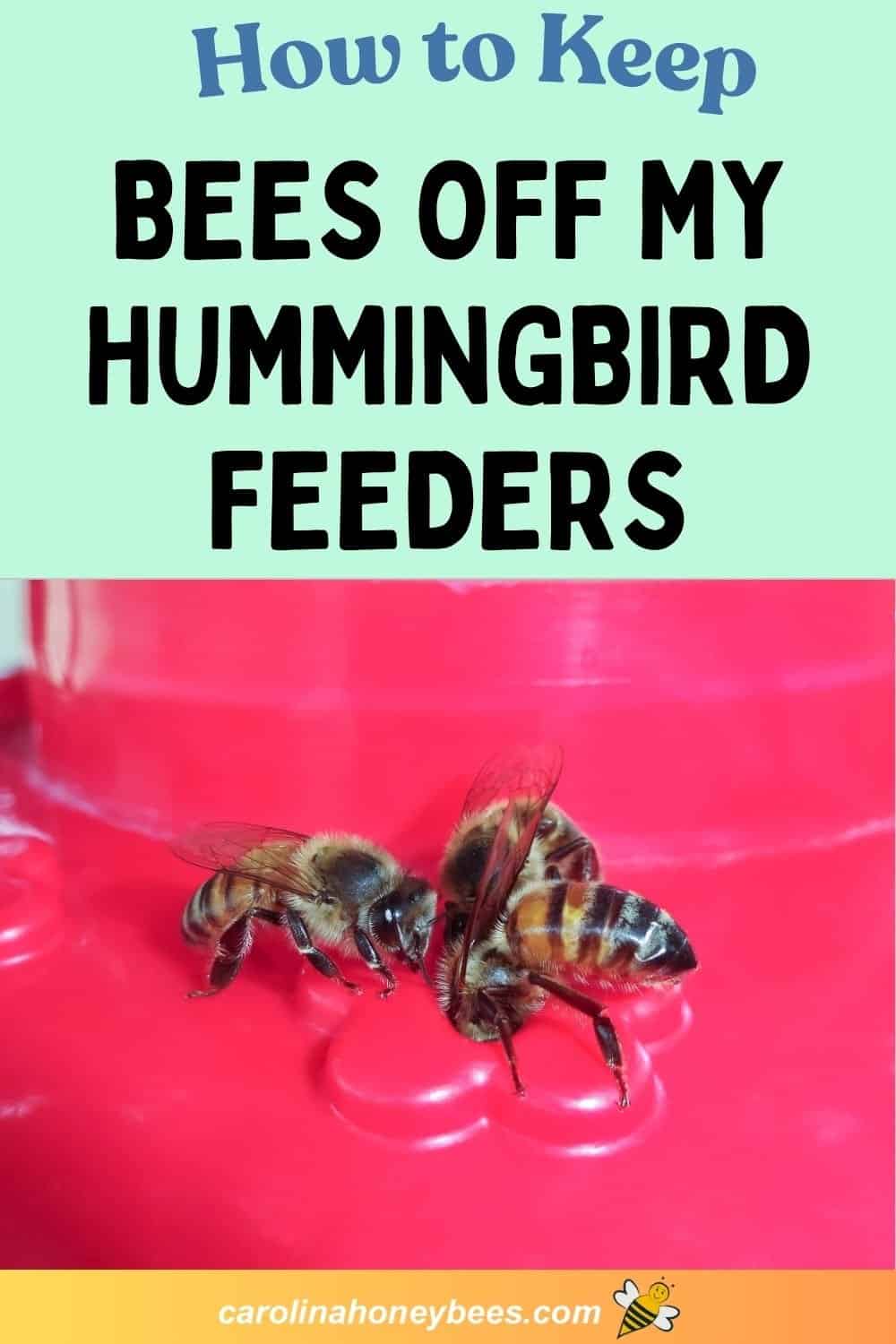Keep Bees Away From Hummingbird Feeders
If bees are swarming your hummingbird feeders, you are not alone. This can be an all too common problem for homeowners – and even beekeepers. Thankfully, it only occurs during certain times of the season. In this guide, you will learn some tips for keeping bees away for your hummingbird feeders without harming any pollinators.
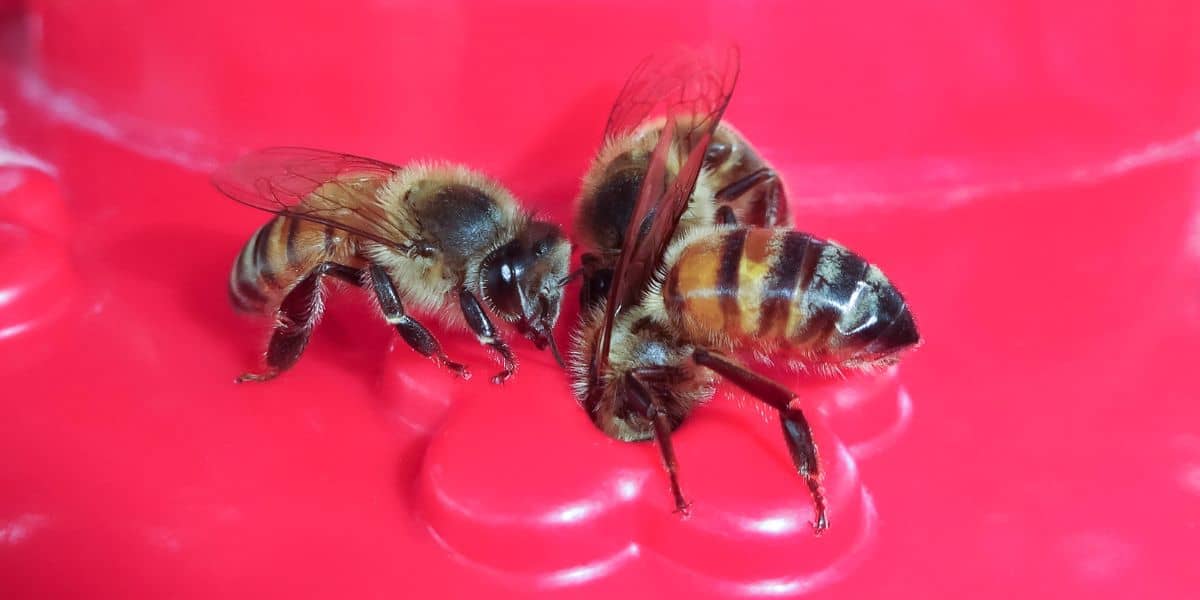
Yes, it is possible for the birds and bees to share the honey bee garden – you worked so hard to create. Whether you have acres of landscape or a few flowering pots on the patio – you can make a difference.
Why Bees are Attracted to Hummingbird Feeders
Bees do an excellent job of finding food sources. They are especially fond of high sugar concentrations – much like the nectar in your hummingbird feeder.
Sweet liquid nectar is used by honey bees to make honey – important food that is stored in the hive for Winter survival. They will make “honey” from any sweet liquid.
And, there hangs your feeders – filled with an abundant source of beautiful sweet liquid. The bees (and wasps) see an opportunity – can you really blame them?

When Bee & Wasp Problems are Most Common
The occasional bee or wasp stopping by a sip – is not usually a big problem. But, at certain times of the year, bee visitors can be a very big issue.
Late Summer thru Fall is the most common time of year that I hear complaints about bees. Also, anytime the area is experiencing a decrease in natural nectar – called a nectar dearth.
During these times, bee colonies are large – at peak population. A lack of nectar in the field and the need to prepare for Winter create an enticing opportunity.
If you are lucky, the problem will only be temporary (a few weeks). Returning rain and the resulting nectar-rich flowers will cause the bees to return to the field – they prefer natural food sources.
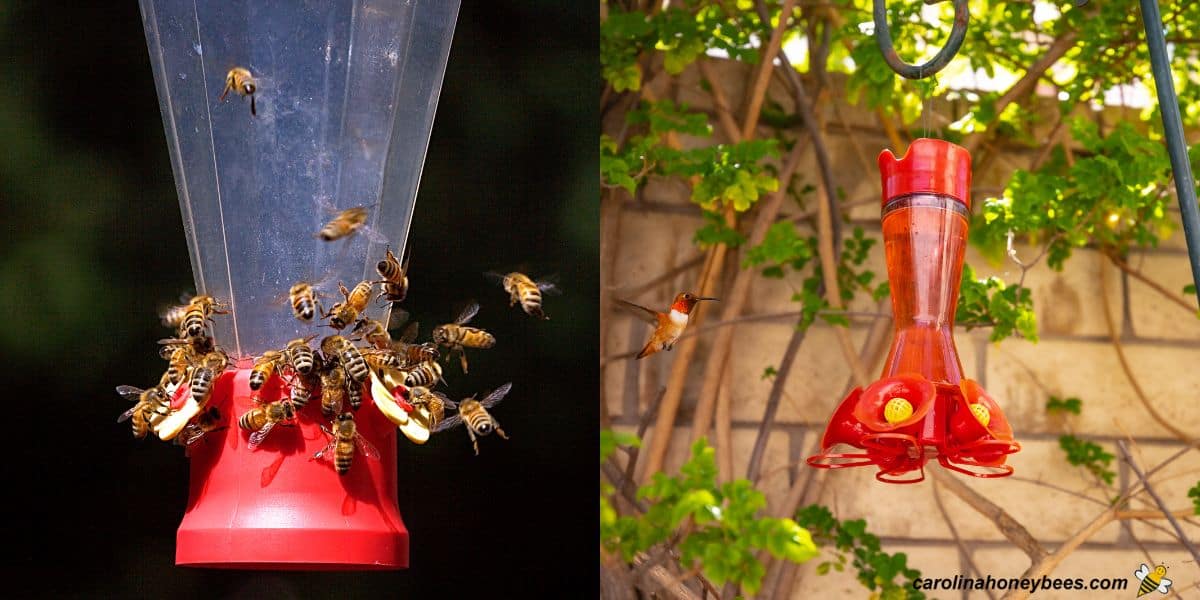
Choosing the Right Feeder
The best way to keep bees from taking over your hummingbird feeder is to stop it before it starts. It is much easier to prevent the problem-than fix it. Once they get tuned into a food location, it can be difficult to stop the behavior.
Feeders are available in a wide variety of beautiful colors and forms. The problem is – they make it very easy for bees and wasps (both sugar lovers) to access the food.
Therefore, if you routinely have bees circling your hummingbird feeders – it might be time to reconsider your feeder choice.
- choose a hummingbird feeder with bee guards
- look for all red feeders – avoid the color yellow (very attractive to bees)
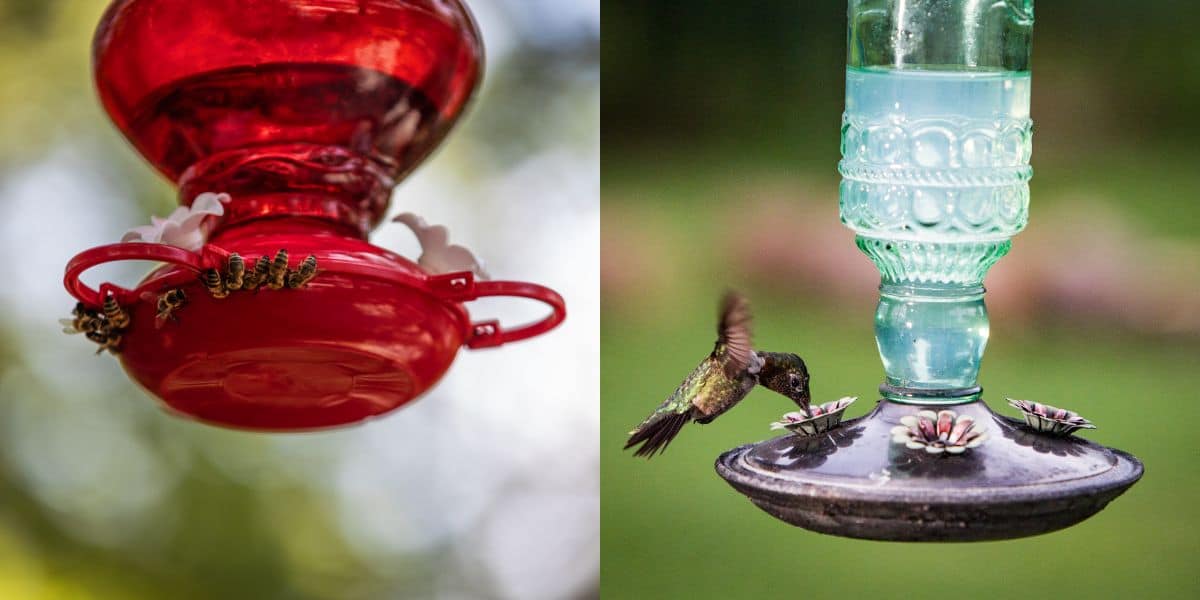
This post may contain affiliate links. As an Amazon Associate, I earn from qualifying purchases. Please read my disclosure.
Bee Proof Feeders
With proper bee guards, the birds will be able to reach deep down to access the syrup with their long tongues. Insects will not be able to access the syrup and have to reason to revisit.
You may be able to purchase bee guards for your existing saucer feeders. This is the most effective deterrent for keeping bees away from feeders and outdoor areas. No access to sweet liquid.
In addition, manufacturers have redesigned some hummingbird feeders to have more narrow feeding tubes – this reduces the opportunity for bees to feed.
Avoid Yellow Inserts
Red attracts hummingbirds – yellow attracts insects. Common hummingbird feeders are red and yellow because that is a bright cherry combination. It looks attractive to the homeowner.
Look for a feeders that doesn’t have the bright yellow centers. Look for red hummingbird feeders with white or red feeding ports.
There are many elegant hummingbird feeder styles to choose from. If you already have a feeder with yellow ports, paint them red using non-toxic paint.
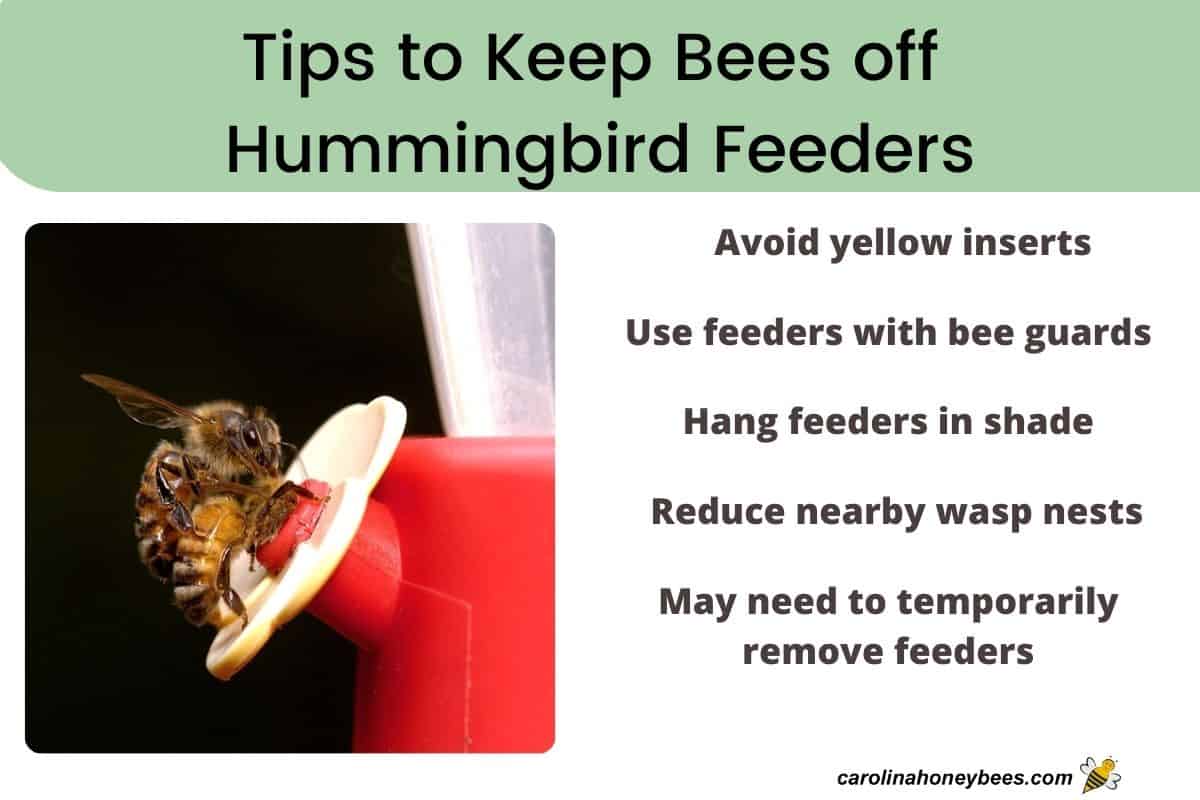
Natural Ways to Repel Bees & Wasps From Feeders
These bee-friendly tips can help you keep bees away from your feeders without harming other insects.
- leaky feeders are a no-no – check for leaks
- place feeders in a shady location – bees love sun
- eliminate any nearby wasp nests
- plant flowers that bees love that bloom during the dry season
- use less sugar – reduce the feed concentration for a while
- peppermint oil
- bee repelling plants
- take away feeders for a short time
Stop Leaks
At the beginning of the season, check your hummingbird feeder for leaks. Even small drips of sugary syrup can attract bees and wasps.
If the drip persists, try using some plumber’s tape on the threads between the bottle reservoir and base.
Use it only on the screw threads – do not let it be in contact with the liquid feed. And of course, avoid getting syrup on the outside of the feeder when refilling-rinse it off.
Hang Feeders in the Shade
Hummingbirds will seek out the food source as they forage naturally in the yard. Honey bees prefer food sources that in full sunlight. If you have several good spots to choose from, hang your hummingbird feeder a shaded area.
You can even enjoy feeding hummingbirds while on vacation in your RV or camper. Everyone loves a picnic!
Remove Nearby Wasp Nests
Wasps from nearby nests will come to your feeder. Remove them before they grow large. Some homeowners use a “fake wasp nest” to prevent the insects from building.
Maybe you will have luck with that but it sure did not fool my wasps – LOL.
Increase Nectar Rich Flowers
It may not help this season but develop a plan for next year. Add some new flowers to the pollinator garden – sunflowers that attract bees, bee balm or zinnia are good choices.
Choose landscape plants that bloom during the hot dry Summer. Drought tolerant flowers that bees love will help lure them to this natural food source.
Stagger the bloom throughout the warm months. And, don’t forget the Fall Blooming Flowers that begin in late Summer.
Use Less Sugar
The typical mixture for hummingbird feed is 1 part sugar to 4 parts water. This is a bit below the preferred sweetness ratio for honey bees-in normal conditions. That is why most of us have no problem with bee visitors unless natural forage is lacking.
If a problem continues at your feeder for more than a few days, experiment with making the sugar syrup just a bit less sweet.
Peppermint Essential Oil
Some bird lovers report success by using a small dab of peppermint essential oil on their feeders. They say the birds don’t mind while the bees do not like the scent. It might be worth a try if all else has failed in your quest.
Use Bee Repelling Plants
This idea will not work for those of you that hang your feeders up high. But, if you have some of the low hanging bird feeders, choose some plants that help repel bees to hang nearby.
For minor problems, you might place some of these in hanging baskets near your feeder (mints, eucalyptus).
Take Feeder Away
Nothing works in every situation. If you try these tips and still have a massive problem, it may be necessary to remove your hummer feeders for a week or two. Hopefully foraging conditions will improve and the bees will refocus on nectar.
Tips for Beekeepers
If your neighbor enjoys feeding hummers and you have hives sitting in your yard – naturally you may get blamed because YOUR bees are causing the problem. Perhaps they are and they may bother your own feeders too.
I have rarely had a problem with this over the years – even when I had 25 hives on site. There are things beekeepers can do to ease the situation.
- create feeding stations in times of scarcity
- educate your neighbors on the hopefully temporary situation
Create an Bee Feeding Station
For just one or two hives, use could use a bee watering station (this one is for water but it would work as a sugar water feeder).
This is best used as a temporary solution. Make a mixture of sugar water – (2 parts white cane sugar dissolved in 1 part water) in a shallow dish or pan filled with marbles, gravel or stones (so no one will drown).
For several hives in a temporary drought, perhaps a DIY bucket feeder or similar method would be better.
Understand though, that this type of feeder attracts every sugar loving insect in the area – it should not be placed near the house or near the beehives. Be cautious – you may have a lot of bees visiting. Keep it away from human traffic etc.
Please, do not feed bees honey as a lure. It can contain spores of bee diseases such as American Foulbrood – harmless to humans but kills bee colonies. Yes, even honey from the supermarket is a bad idea.
Educating Non-Beekeepers
Public education should be a part of every beekeeper’s life. Helping “good” neighbors understand why bees behave in a certain way can make everyone’s life better.
In the majority of cases, bees swarming the hummingbird feeders is temporary and may resolve itself in a short time.
Things You Should Never Do
Don’t resort to harsh chemicals or pesticides to get rid of bees on your hummingbird feeders. Using any type of repellent product on the feeder – can harm you and the birds too!
Honestly, they are not very effective either. Ants can also be a problem (ants can invade beehives too) as they try to secure the sweet sugar syrup.
You can purchase “ant-guards – (also called ant moats)” or use some petroleum jelly on the hanger for ants. This wont work for honey bees of course – they fly!
Be Careful With Insect Traps
Be careful with traps used to lure in wasps and hornets. You may end up harming the local bee populations.
If you like to make – homemade yellow jacket traps, don’t make the bait too sweet. You may attract bees but it will not lure them away from your hummer feeders.
FAQs
Hummingbirds are not afraid of bees. But, they find it frustrating to deal with hundreds of bees at the feeder and may choose not to feed.
While there are some birds that consume bees as part of their diet – hummingbirds do not eat bees.
Beekeepers can not keep bees away from your hummingbird feeder. But they may minimize the problem by providing sugar water for bees in times of serious nectar dearth.
A Final Word
In the field, you will see hummingbirds sharing flowers with bees and wasps. There are many different blooms available and enough space for everyone to spread out.
However, a blooming bush or shrub has many feeding stations (flowers) to visit – a feeder does not. So, this can cause a traffic jam between the bees and hummingbirds at the feeder. Do what you can to create harmony in the garden.

